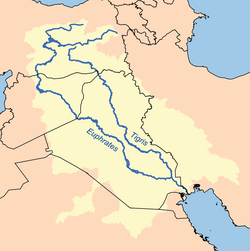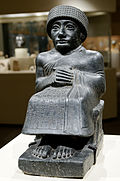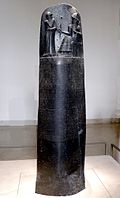Mesopotamia
Mesopotamia (Ancient Greek: Μεσοποταμία - "land between rivers") is a historical region in the Middle East. It included most of today’s Iraq, and parts of modern-day Iran, Syria and Turkey. The 'two rivers' of the name referred to the Tigris and the Euphrates rivers.
Overview
The land was called Al-Jazirah ("the island") by the Arabs, and Egyptologist J.H. Breasted later included it in the Fertile Crescent. The region is bounded in the northeast by the Zagros Mountains and in the southeast by the Arabian Plateau. The area is often called the cradle of civilization. The ancient writing system, or alphabet, is called cuneiform. It was first used around 3000 BC by the Sumerians. Historically important cities in Mesopotamia included Uruk, Ur, Nippur, Nineveh and Babylon.
Major territorial states were the Akkadian kingdom, the Third Dynasty of Ur, and the Assyrian Empire. Some of the important historical Mesopotamian leaders were Ur-Nammu (king of Ur), Sargon of Akkad, the founder of the Akkadian kingdom, Hammurabi, who established the Old Babylonian state, and Tiglath-Pileser I, who started the Assyrian Empire.
Many advances in technology were made by the ancient Sumerians, such as irrigation,[1] trade by river, and flood control. Sumerians had agriculture and domesticated animals, or livestock, from the earliest records. Babylon is likely the first city built by settled people. Mesopotamia was also the place where the wheel was first used. First it was a potter's wheel that was used to make clay pots, then Sumerians adapted it for transport.
Geography
Mesopotamia is made up of different regions. Northern Mesopotamia is made up of hills and plains. The land is quite fertile due to seasonal rains, and the rivers and streams that come from the mountains. Early settlers farmed the land and used timber, metals and stone. Southern Mesopotamia is made up of marshy areas and wide, flat, plains. Cities developed along the Euphrates and Tigris rivers flowing through the region. Early settlers had to irrigate the land along the banks of the rivers to grow their crops.[2][better source needed]
Inhabitants
Mesopotamia has been conquered many times by many different people. It was the heartland of the Sumerian, Akkadian, Babylonian and Assyrian empires. As each new group moved into the region they adopted some of the culture, traditions, and beliefs of the people who had come before. It was conquered by Alexander the Great (332 BC), the Parthians (150 BC), the Romans, the Persian Empire and the Arabs (7th century). It is still one of the most fertile parts of the Middle East.
Ancient Mesopotamia begins in the late 6th millennium BC, and ends with either the rise of the Achaemenid Persians in the 6th century BC or the Muslim conquest of Mesopotamia in the 7th century CE. This long period may be divided as follows:
- Pre-Pottery Neolithic:
- Jarmo (~7000 BC– ~6000 BC)[3]
- Pottery Neolithic:
- Chalcolithic or Copper Age:
- Ubaid period (~5900 BC–4400 BC)
- Uruk period (~4400 BC–3200 BC)
- Jemdet Nasr period (~3100 BC–2900 BC)
- Early Bronze Age
- Middle Bronze Age
- Early Babylonia (20th–18th century BC)
- Early Assyrian kingdom (20th–18th century BC)
- First Babylonian Dynasty (18th–17th century BC)
- Late Bronze Age
- Kassite dynasty (16th–12th century BC)
- Bronze Age collapse (12th–11th century BC)
- Iron Age
- Neo-Hittite or Syro-Hittite regional states (11th to 7th century BC)
- Neo-Assyrian Empire (10th–7th century BC)
- Chaldea, Neo-Babylonian Empire (7th–6th century BC)
- Classical Antiquity
- Late Antiquity
Epic of Gilgamesh
The Epic of Gilgamesh is an ancient story about a relationship between Gilgamesh and his close companion, Enkidu. Enkidu is a wild man created by the gods as Gilgamesh's equal to distract him from oppressing the citizens of Uruk.
Together they undertake dangerous quests that incur the displeasure of the gods. Firstly, they journey to the Cedar Mountain to defeat Humbaba, its monstrous guardian. Later they kill the Bull of Heaven that the goddess Ishtar has sent to punish Gilgamesh for turning down her advances.
The second part of the epic is about Gilgamesh's distressed reaction to Enkidu's death, which takes the form of a quest for immortality. Gilgamesh attempts to learn the secret of eternal life by undertaking a long and perilous journey to meet the immortal flood hero, Utnapishtim. The words addressed to Gilgamesh in the midst of his quest foreshadow the result:
The life that you are seeking you will never find. When the gods created man they allotted to him death, but life they retained in their own keeping.
Mesopotamia Media
Mesopotamian Marshes at night, southern Iraq. A reed house (Mudhif) and a narrow canoe (Mashoof) are in the water. Mudhif structures have been one of the traditional types of structures, built by the Marsh people of southern Mesopotamia for at least 5,000 years. A carved elevation of a typical mudhif, dating to around 3,300 BC was discovered at Uruk.
One of 27 Statues of Gudea, a ruler around 2090 BC
After early starts in Jarmo (red dot, c. 7500 BC), the civilization of Mesopotamia in the 7th–5th millennium BC was centered around the Hassuna culture in the north, the Halaf culture in the northwest, the Samarra culture in central Mesopotamia and the Ubaid culture in the southeast, which later expanded to encompass the whole region.
The Code of Hammurabi is a Babylonian legal text composed c. 1755–1750 BC. It is the longest, best-organised, and best-preserved legal text from the ancient Near East. It is written in the Old Babylonian dialect of Akkadian, purportedly by Hammurabi, sixth king of the First Dynasty of Babylon.
The Epic of Gilgamesh, an epic poem from ancient Mesopotamia, regarded as the earliest surviving notable literature.
A clay tablet, mathematical, geometric-algebraic, similar to the Euclidean geometry. From Shaduppum Iraq. 2003–1595 BC. Iraq Museum.
The Burney Relief, First Babylonian dynasty, around 1800 BC
Related pages
References
- ↑ The use of small canals in order to move water through fields.
- ↑ British Museum
- ↑ ~ means 'about'.
Other websites
- Mesopotamia
- Mesopotamia—introduction to Mesopotamia from the British Museum










